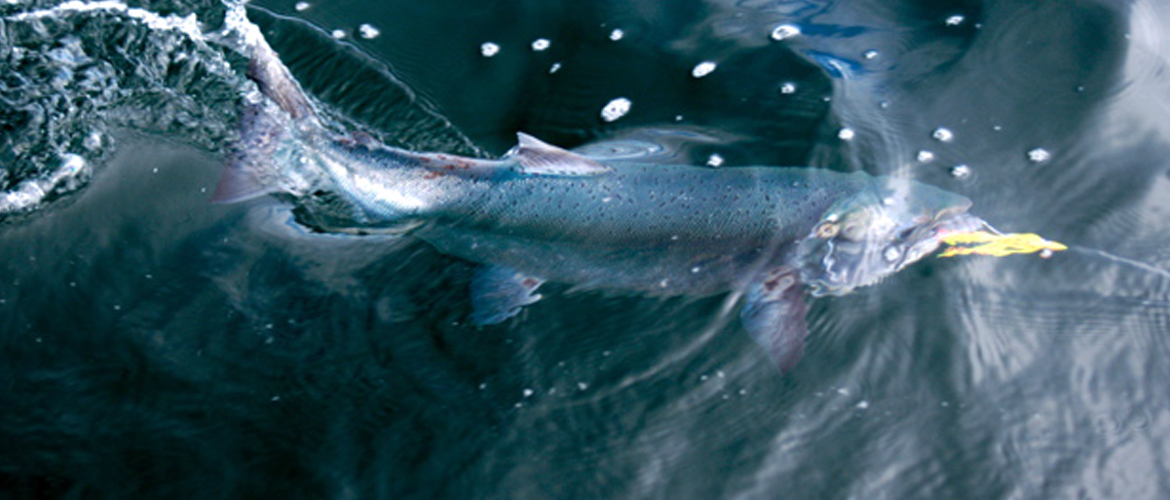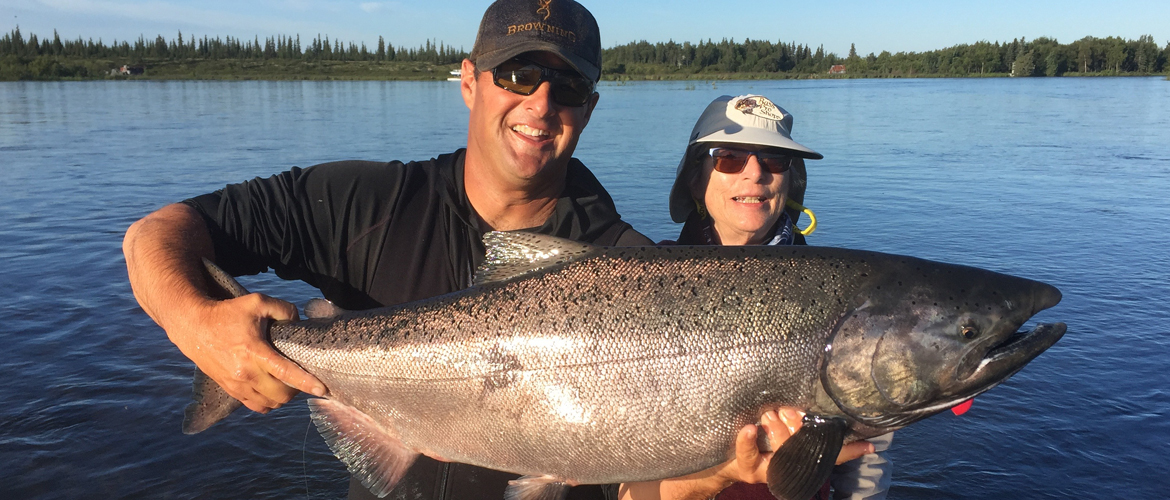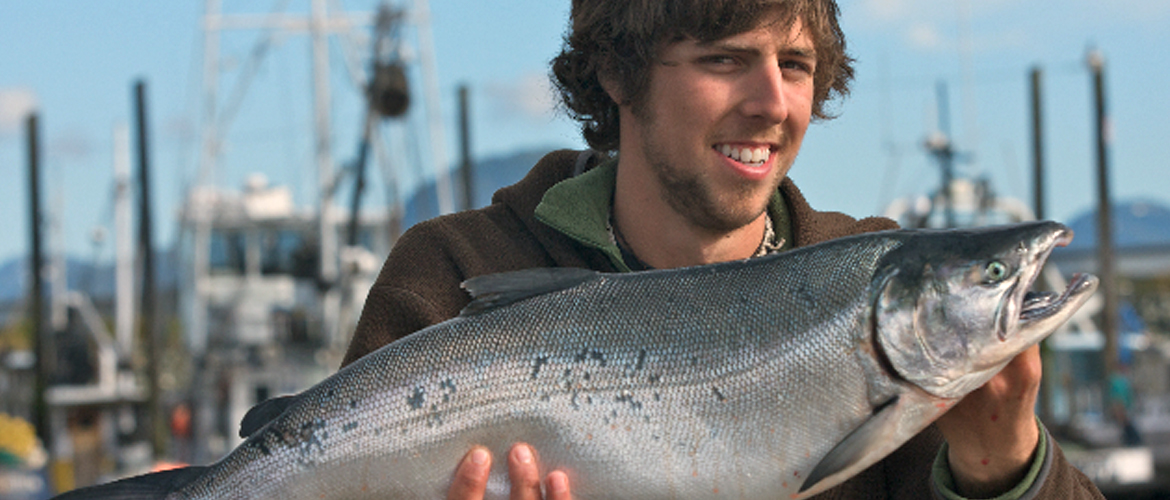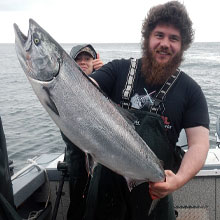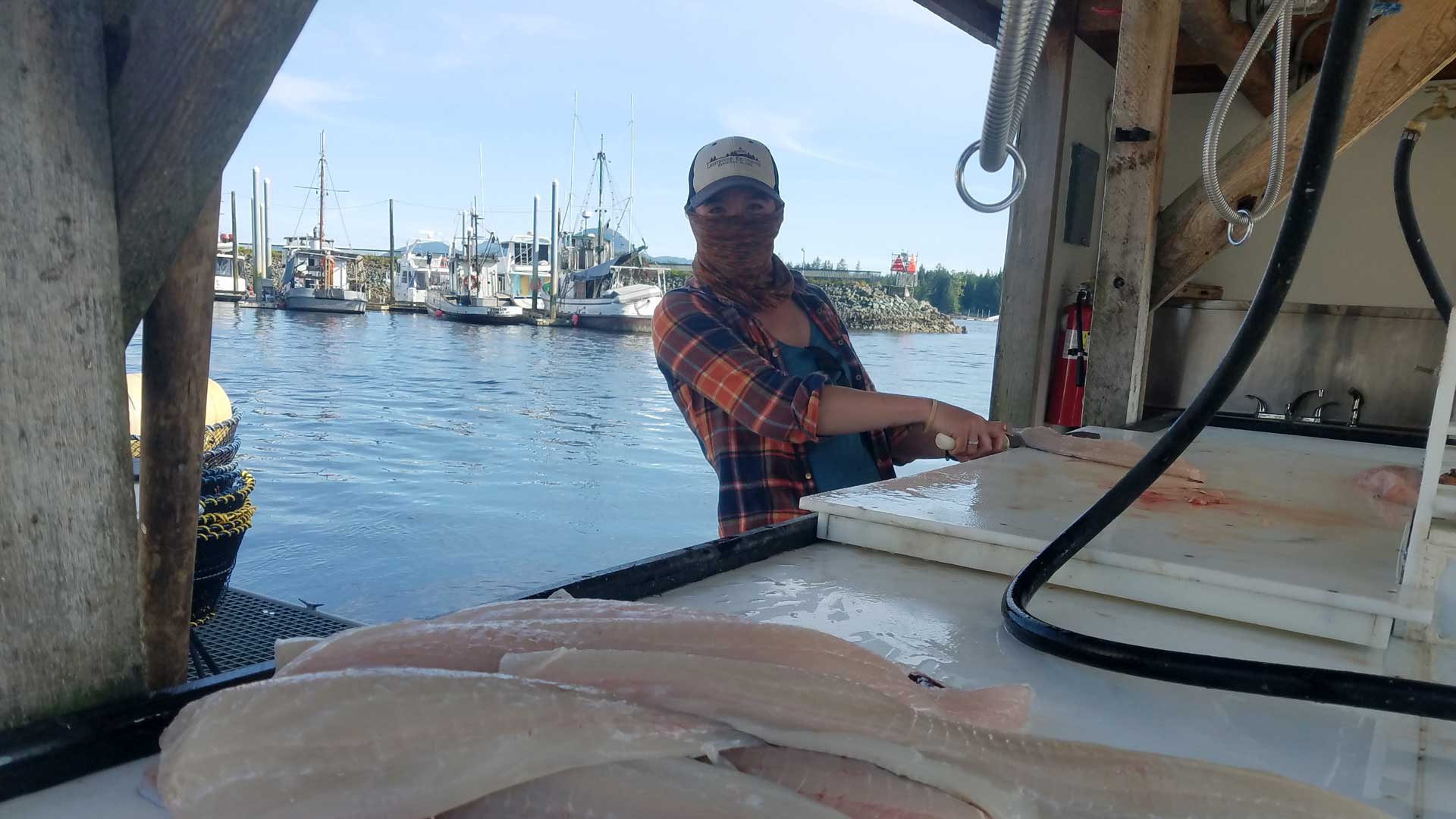Discover Alaska Salmon
THE FACTS:
- NAMES:
- King, spring, tyee, blackmouth (immature form), smiley
- RANGE:
- Pacific Rim – Hokkaido, Japan to central California
- SIZE:
- Usually 20 to 30 pounds up to nearly 100 pounds
- WORLD RECORD:
- 97.25 pounds
- FISHING
TECHNIQUES - Mooching, jigging, trolling
Alaskan Salmon
In the world of Alaskan sport fishing, salmon are the true athletes. There are five species of Alaskan salmon and each is a superbly fast swimmer. Salmon spend their lives chasing prey and masterfully avoiding predators. To the salmon's detriment, however, all that exercise makes for a deliciously tender meal!
Salmon has been a staple in locals' diets since the Alaska Natives first made Ketchikan their home. It is even hypothesized that the abundance of spawning streams near Ketchikan was the reason they settled in the area. Both commercial and subsistence salmon fishing have helped to create the character and charm of Ketchikan. From providing jobs, to keeping local bars in business, salmon fisherman help sustain the local economy.
In Ketchikan, and all over southeast Alaska we are proud of the management style by which we have maintained the healthy livestock of all five species of salmon. Through extensive yearly research, fish counting, and hatcheries funded by non-other than the fisherman themselves, we are proud to boast one of the most sustainable fisheries in the world!
Salmon Species
While wild salmon stocks are abundant throughout Alaska, Ketchikan is the only city in the state that is home to healthy runs of all five species of Alaskan salmon: king, coho, sockeye, pink and chum. Because this is true, Ketchikan is known as "The Salmon Capital of the World." (For disbelievers, one look at our huge sign should settle all doubt.)
King Salmon (Chinook)
King's are by far the largest of Alaska's salmon. Ranging between 18-50 lbs. and 32-48 inches, you can normally tell a king by its size. Troll-caught commercially, one-at-a-time, king salmon are handled with extreme care, glazed and blast frozen to lock in all the Omega-3s and fresh-caught taste. The largest king salmon sport-caught in Alaska to date was 97.4 lbs.
Kings of Herring Cove
Each spring 700,000 King Salmon smolt leave the Herring Cove estuary for the open ocean. These young salmon spend the next five to seven years circumnavigating the Gulf of Alaska growing strong and more powerful. The surviving Kings returning to Herring Cove can achieve weights of up to seventy pounds. Herring Cove, just south of Ketchikan, is recognized by the Alaska Department of Fish and Game as the most productive King Salmon fishing grounds in the state. The extraordinary nature of this King run at Herring Cove attracts an abundance of bears, seals and eagles, making this fishing destination a truly Alaskan experience.
Your trip begins in the outfitting room where you are fully geared up for the Alaska weather. Your local guide will then escort you to your boat, designed specifically to fish for King Salmon at Herring Cove. Trolling with down riggers, jigging, and motor mooching are some of the salmon fishing techniques you might employ. Additionally, each salmon guide has evolved their own secrets for catching Herring Cove Kings, which they will share with you as you pursue your King. Fisherman travel worldwide in search of exceptional salmon fishing; in Southeast Alaska, Herring Cove is where they go for Kings.
Fishing for Kings at Herring Cove is best from June 15th through July 15th, as this is the traditional height of the King Salmon run.

Coho Salmon (Silver)
Prized by sport fishers for their propensity to put up a good fight, cohos can be identified by their dark metallic blue backs, bright silvery-blue sides, and feisty spirit. They are also troll-caught commercially and sent out into the market whole and frozen. They range in size between 6-15 lbs average, with the sport-caught state record being 26 lbs.

Sockeye Salmon (Red)
At 5-12 pounds, sockeye salmon are the slimmest and the most streamlined of the five species of Alaskan salmon. When they're in the ocean, sockeye salmon are a greenish-blue color with silver sides and a white or silver belly. When they're ready to spawn, however, they turn a bright vermilion red. Due to the high concentration of oils and Omega-3 fatty acids, sockeye salmon are the perfect choice for smoking.

Pink Salmon (Humpy)
The baby of the family, pinks weigh in between two and ten lbs. Because they are “schoolers” and travel in large packs, most pinks are caught en masse by a large seine net. Pink salmon are small and much less oily than other salmon species, which makes them the perfect fish to can. They can be recognized by their pinkish-silver, black polka-dotted bodies and spotted tails.

Keta Salmon (Chum or Dog)
With dark metallic greenish-blue backs and sides that fade into silvery bellies, keta salmon is prized for its roe. For this reason, commercial fishermen take care to chill the fish to 33°F, no colder, which keeps the eggs properly chilled but not frozen. Once the roe is extracted, keta salmon are cleaned and frozen whole. The only salmon species without spots, keta grow to be between 6-26lbs, with the current state sport-caught record holding at 32lbs.

Salmon Life-Cycle
One thing is for sure: If humans had to go through what wild salmon do in order to reproduce, the human race would surely be on the verge of extinction. Think about this: If, in order to reproduce, you had to swim as many as 2,000 miles (the last 50 to 1,000 or so upstream), dodging ferocious predators the whole way, with no hope of surviving the experience, you'd probably think twice about doing your part to ensure the survival of your species, yes? Thank goodness salmon are instinctual creatures that lack any ability to reason, or wild salmon would have gone the way of the dodo bird a long time ago.
Consider the salmon's harrowing lot: After spending the bulk of its life swimming around in the ocean eating zooplankton and krill, there comes a time in every salmon's life when he or she knows it's time to spawn. One day, its dual biological clock/homing device goes off and off it goes: swimming toward its natal stream.
In a beautiful bit of poetry, salmon spawn and die in the very same place they were born. Once in their natal spawning ground, females dig into the gravel riverbed with their tails to make a nest and deposit their eggs. Males, their usefulness spent, die shortly after fertilizing the eggs. Females live long enough to guard their eggs for several weeks. Then they die too, leaving their tiny little offspring to fend for themselves.
The most harrowing part of a salmon's life is when they're small fries because, as you can imagine, everyone and their mother is out to eat them. Once they grow too big for most air- or sea-dwelling predators to eat, a salmon's main job (aside from avoiding nets and sharp hooks) is to bulk up for the final journey – the one that takes it home to spawn.
Salmon in the prime of their lives are called "ocean brights" because they are bright silver. When it's time to make the marathon swim back home, salmon use all their strength and reserves – like a marathoner running up hill for the last five miles of the race – to make it to their destination. At the same time, they begin to physically change, depending on the species, from silver to bright red or green. Once they enter their natal streams, salmon stop eating and use every bit of stored energy to swim upstream, spawn and die. Each parent's decaying body provides nutrition for the tiny salmon-to-be. And the cycle is complete.
Sustaining Wild Salmon
When you're the architect of a plan with a long-term payout, you don't always live to see the fruits of your labors. But from where local Ketchikanite and commercial troller Jim Bray sits, things are looking pretty good – thanks, in large part, to the measures he and other commercial fishermen took to ensure the health of Ketchikan's salmon fishery nearly 40 years ago.
"Things were getting pretty slim pickings around here with cohos and king salmon," says Bray, referring to dwindling salmon runs back in the 70s. Due to overfishing, less and less fish were returning to spawn, which spelled disaster for the fishery's future.
"We got disgusted with the state because they didn't seem to be doing anything about it," says Bray, "so, we formed this organization we called SSRAA where we put three percent [of our annual gross salmon stock (earnings)] into this fund that helped support those hatcheries and got them started." SSRAA, which stands for Southern Southeast Region Aquaculture Association, currently runs four hatcheries in Southeast Alaska, all of which exist to augment the number of wild salmon returning to their natal streams each year.
Each year, the hatcheries release close to 137M king, keta, coho and sockeye salmon into the wild, all of which will experience one of three fates: They will either be caught by commercial or sport fishers, eaten by predators, or live to spawn and die.
"The whole fishing industry has benefited from our hatchery fish," says Bray. "We used to have a lot of ups and downs in our fisheries ... good years and bad years. It seems like it's more leveled out now. It's always a pretty good year."
Say No to Fish Trips
There is a fine line between catching fish and trapping them. Catching them requires time and skill, patience and passion. Trapping fish, specifically the way it used to be done back in the early part of the 20th century – with enormous commercial traps – required not much more than corporate money and greed ... oh, and the blind eye of the federal territorial government.
Salmon are very predictive creatures. They swim home to their natal streams to spawn and die when they are two to six years old, depending on the species. Commercial fish traps worked by essentially laying in wait for homebound spawning salmon. At the peak of the fish trap era, there were 800 traps in the state of Alaska, all strategically placed at the mouths of salmon streams. And they were workhorses, responsible for "catching" two-thirds of all the salmon being processed in the state.
"They were too efficient was the thing," says Jim Bray, 82, a commercial troller who started his fishing career in 1955. "There wasn't much fish got by them!"
As more and more corporate fish traps were installed, canneries began sprouting up along Alaska's Southeast coastline. By the height of the canning boom in 1930, Ketchikan was home to 13 canneries and cold storages, making Alaska's First City the bona fide "Salmon Canning Capital of the World."
By 1960, however, salmon stocks in Alaska were showing signs of overfishing. Because less and less fish were getting into the streams to spawn, there were less and less fish to catch or trap. The commercial fishermen were suffering and canneries started to close. "It got to be real slim pickin's around here!" says Bray.
When Alaska became a state in 1959, the people of Alaska finally had a say in how the state's resources were used. In a concerted effort to save and sustain wild salmon runs, Alaskans said "enough is enough" and voted to ban fish traps for good. Did it work? Well. In the early 1960s, approximately 25M salmon were caught in the statewide commercial fisheries. In recent years, the yearly statewide salmon catch has been exceeding 200M salmon a year. So, yes. It worked.
Why We Fish
When the locals in Ketchikan go out fishing, they do it for two reasons: love and dinner. Longtime Ketchikanite Ron Medel, a self-described "fish fanatic" loves fish and fishing. And since he fishes, primarily, to put food on the table, you could say he's fishing for the right reasons. "I fish to provide food for my friends and family," he says. "That's probably the biggest reason for a guy who loves fishing to live here: lingcod, yellow eye, halibut, salmon... this is some of the best and healthiest food you can eat! We eat fish five days a week, pretty much all year long!"
Medel, a fisheries biologist with the Tongass National Forest, goes fishing at least two days a week during peak season (May through September). "I don't take any more fish than we can eat fresh, freeze, or give to friends," he says. His rule of thumb is to never take more fish than you can properly process within a couple of days. "I always say, 'Take care of your fish and it will take care of you!'"
Immediate cleaning and proper cooling is key, says Medel. It stops the natural deterioration of the fish (a process that starts as soon as you pull a fish out of the water) and serves to lock in the flavor and all the health benefits inherent in fresh, wild fish.
It's not difficult to properly process your fish, says Medel. All it takes is a little time and skill, a sharp knife, a good vacuum-sealer, and a refrigerator/freezer. For those who don't have the time or inclination, however, there are several places in Ketchikan that specialize in sealing, freezing, smoking and/or canning fresh-caught fish. Once properly processed, it's ready whenever you are – full of healthy Omega-3s and fresh-caught flavor.
